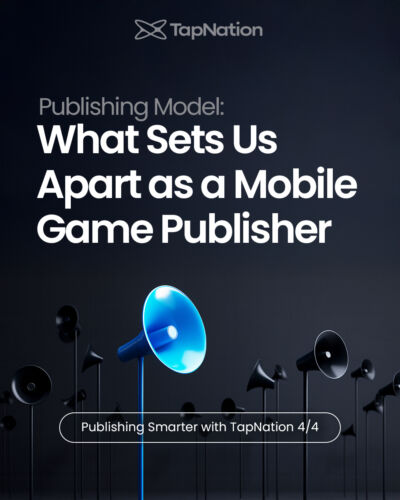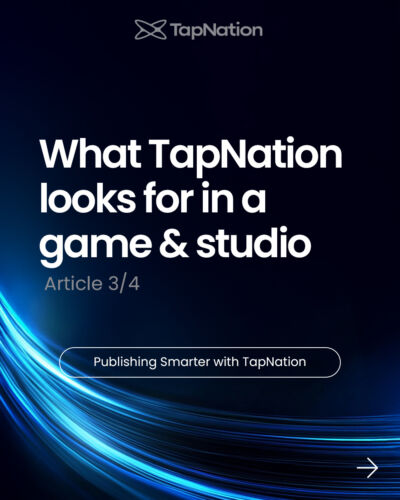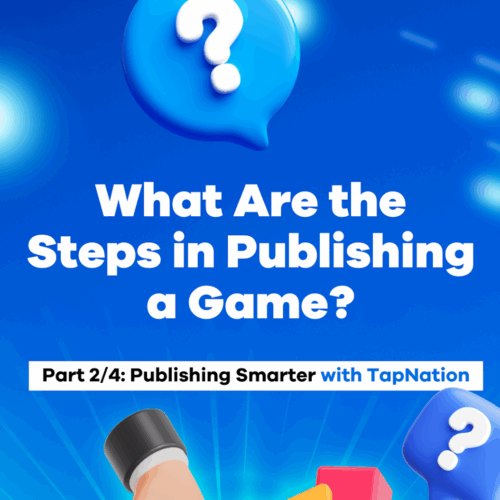Mertcan Dogrucan – October 1, 2025
Introduction
Publishing a game in 2025 isn’t just about uploading a build to the store — it’s a whole system. Successful publishers rely on a framework built on experience, clarity, collaboration, and data. Whether it’s submitting a game, selling a project, or exploring a prototype agreement, having a well-defined process in place ensures smooth collaboration for all parties involved.
Let’s dive into the step-by-step guide on how publishing actually happens
Step 1: First Touch Point — Submit Your Game
“Submit your game” isn’t just a form, it’s your first impression.
Some studios send playable APKs. Others reach out with early concepts or prototypes. A finished game isn’t required but the more that’s built, the better the chances. A well-developed prototype or portfolio with clear gameplay and direction gives publishers something real to evaluate and gets one step closer to publishing.
If the prototype catches attention, the publisher team gets in touch to discuss next steps — often starting with a collaborative GDD and market discussion.
Step 2: Prototype Testing
Once a playable version is available, publishers run test campaigns — often on platforms like Facebook, Google or Mintegral — to measure the game’s appeal with real users. The goal at this stage is to understand whether the core gameplay has go-to market potential.
Many publishers focus on cost per install (CPI) and early retention to quickly validate prototypes. A low CPI generally indicates strong visual and conceptual appeal in ads, while retention and playtime help assess gameplay quality (engaging and fun).
Key metrics to test include:
- CPI: Is the cost per install efficient?
- Retention: Does your game manage to hook players in the short term (D1, D3, D7) and long term (D14, D30…)?
- Playtime: Are sessions engaging enough?
- LTV: Is there long-term monetization potential?
Note from TapNation: At TapNation, we prioritize building attractive creatives and tailoring campaigns based on audience behavior. For example, Gen Z users on TikTok often respond differently than older demographics on Facebook, so CPI benchmarks and creative strategies are adjusted accordingly.
At this stage — and every one after — we value fast, transparent, and dynamic communication with the studio.
Step 3: Iteration – Adding Content and Balancing
If the prototype shows promise and hits the right KPIs, publishers move into the next phase: adding content and balancing the game economy. This stage is critical. Without proper balance, new systems can break the gameplay.
It includes:
- Adding more levels, features, and gameplay elements
- Finalizing the in-game economy structure (core to level design)
- Creating a new game design document based on prototype data
- Ensuring the game remains fun and engaging as it grows
- A/B testing game changes to optimize KPIs
- Marketing and QA Tests
- Localization — to prepare for global rollouts with full translation and adaptation
- Communication channels for the users
Note from TapNation: When we believe in the prototype it happens we go for another iteration because the feeling between TapNation and the studio matters a lot. This phase ensures we’re not just scaling a good idea — we’re scaling a strong product. The goal is not just to expand a promising prototype, but to ensure scalability, replayability, and monetization potential. We start by updating existing GDD based on prototype results, then define the economic structure and plan the content rollout.
Step 4: Integrating Live Ops
When a game hits performance benchmarks, publishers prep for LiveOps:
- LiveOps Activation — We introduce special in-game events, manage regular updates, and maintain long-term engagement with our dedicated LiveOps team .
- Community & Marketing Setup — We help establish Discord servers, social media accounts (Instagram, Facebook, TikTok), and support systems to grow your player base and boost organic reach.
- Go-to-Market Support — With launch communication and event planning, we make sure your title hits the market with maximum visibility and momentum.
Live Ops is where long-term engagement and revenue come to life which is a key piece of effective mobile game monetization strategies.
Note from TapNation: TapNation supports studios with dedicated Live Ops management by assigning a dedicated Live Ops manager to each game, player community setup, and go-to-market planning ensuring titles launch with both strategic momentum and post-launch engagement tools.
Final Word
Publishing a mobile game today is not a one-time event — it’s a structured, collaborative process. From early testing to global rollout, successful publishing requires iteration, transparency, and aligned goals between studio and publisher.
Studios looking to scale need more than just funding. They need a partner that can provide insights, infrastructure, and operational support across game design, marketing, monetization, ASO, UA, and Live Ops.
That’s why at TapNation, publishing isn’t a handoff — it’s a partnership. From early concepts to launch day and beyond, we co-create and co-pilot every step with a studio. This collaborative approach is what makes us stand out among mobile game marketing agencies and publishers offering game UA services.
Got a game? Or a killer idea? Pitch it to all of us. Reach out through submit your game form and let’s build a hit game together.
Our Success Stories
Thief Puzzle
Wordling
Hero Making Tycoon
Guess Their Answer
Resources
[1] – https://www.tap-nation.io/blog/kpis-that-matter-metrics-to-track-in-hybrid-casual-games/
[2] – https://www.tap-nation.io/blog/how-to-efficiently-manage-live-ops-with-optimized-resources/






